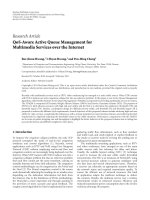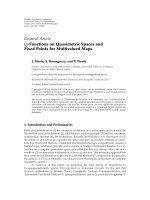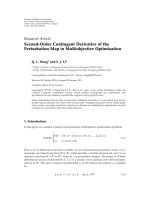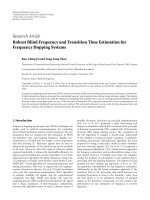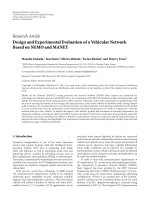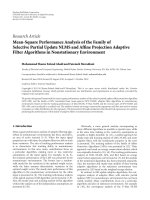báo cáo hóa học:" Research Article Infinitely Many Solutions of Strongly Indefinite Semilinear Elliptic Systems" potx
Bạn đang xem bản rút gọn của tài liệu. Xem và tải ngay bản đầy đủ của tài liệu tại đây (504.7 KB, 11 trang )
Hindawi Publishing Corporation
Boundary Value Problems
Volume 2009, Article ID 865408, 11 pages
doi:10.1155/2009/865408
Research Article
Infinitely Many Solutions of Strongly Indefinite
Semilinear Elliptic Systems
Kuan-Ju Chen
Department of Applied Science, Naval Academy, P.O. Box 90175, Zuoying, Kaohsiung 8/303, Taiwan
Correspondence should be addressed to Kuan-Ju Chen,
Received 16 December 2008; Accepted 6 July 2009
Recommended by Wenming Zou
We proved a multiplicity result for strongly indefinite semilinear elliptic systems −Δu u
±1/1|x|
a
|v|
p−2
v in R
N
, −Δv v ±1/1 |x|
b
|u|
q−2
u in R
N
where a and b are positive numbers
which are in the range we shall specify later.
Copyright q 2009 Kuan-Ju Chen. This is an open access article distributed under the Creative
Commons Attribution License, which permits unrestricted use, distribution, and reproduction in
any medium, provided the original work is properly cited.
1. Introduction
In this paper, we shall study the existence of multiple solutions of the semilinear elliptic
systems
−Δu u ±
1
1 |x|
a
|
v
|
p−2
v in R
N
,
−Δv v ±
1
1 |x|
b
|
u
|
q−2
u in R
N
,
1.1
where a and b are positive numbers which are in the range we shall specify later. Let us
consider that the exponents p, q>2 are below the critical hyperbola
1 >
1
p
1
q
>
N − 2
N
for N ≥ 3,
1.2
2 Boundary Value Problems
so one of p and q could be larger than 2N/N − 2; for that matter, the quadratic part of the
energy functional
I
±
u, v
±
∇u ·∇v uv
dx −
1
p
1
1 |x|
a
|
v
|
p
dx −
1
q
1
1 |x|
b
|
u
|
q
dx
1.3
has to be redefined, and we then need fractional Sobolev spaces.
Hence the energy functional I
±
is strongly indefinite, and we shall use the generalized
critical point theorem of Benci 1 in a version due to Heinz 2 to find critical points of I
±
.
And there is a lack of compactness due to the fact that we are working in R
N
.
In 3, Yang shows that under some assumptions on the functions f and g there exist
infinitely many solutions of the semilinear elliptic systems
−Δu u ±g
x, v
in R
N
,
−Δv v ±f
x, u
in R
N
.
1.4
We shall propose herein a result similar to 3 for problem 1.1.
2. Abstract Framework and Fractional Sobolev Spaces
We recall some abstract results developed in 4 or 5.
We shall work with space E
s
, which are obtained as the domains of fractional powers
of the operator
−Δid : H
2
R
N
∩ H
1
R
N
⊂ L
2
R
N
−→ L
2
R
N
. 2.1
Namely, E
s
D−Δid
s/2
for 0 ≤ s ≤ 2, and the corresponding operator is denoted by
A
s
: E
s
→ L
2
R
N
. The spaces E
s
, the usual fractional Sobolev space H
s
R
N
, are Hilbert
spaces with inner product
u, v
E
s
A
s
uA
s
vdx 2.2
and associates norm
u
2
E
s
|A
s
u|
2
dx. 2.3
It is known that A
s
is an isomorphism, and so we denote by A
−s
the inverse of A
s
.
Now let s, t>0withs t 2. We define the Hilbert space E E
s
× E
t
and the bilinear
form B : E × E → R by the formula
B
u, v
,
φ, ψ
A
s
uA
t
ψ A
s
φA
t
v. 2.4
Boundary Value Problems 3
Using the Cauchy-Schwarz inequality, then it is easy to see that B is continuous and
symmetric. Hence B induces a self-adjoint bounded linear operator L : E → E such that
B
z, η
Lz, η
E
, for z, η ∈ E. 2.5
Here and in what follows ·, ·
E
denotes the inner product in E induced by ·, ·
E
s
and ·, ·
E
t
on the product space E in the usual way. It is easy to see that
Lz L
u, v
A
−s
A
t
v, A
−t
A
s
u
, for z
u, v
∈ E. 2.6
We can then prove that L has two eigenvalues −1 and 1, whose corresponding eigenspaces
are
E
−
u, −A
−t
A
s
u
: u ∈ E
s
, for λ −1,
E
u, A
−t
A
s
u
: u ∈ E
s
, for λ 1,
2.7
which give a natural splitting E E
⊕ E
−
. The spaces E
and E
−
are orthogonal with respect
to the bilinear form B,thatis,
B
z
,z
−
0, for z
∈ E
,z
−
∈ E
−
. 2.8
We can also define the quadratic form Q : E → R associated to B and L as
Q
z
1
2
B
z, z
1
2
Lz, z
E
A
s
uA
t
v 2.9
for all z u,v ∈ E. It follows then that
1
2
z
2
E
Q
z
− Q
z
−
, 2.10
where z z
z
−
, z
∈ E
, z
−
∈ E
−
.Ifz u, v ∈ E
,thatis,v A
−t
A
s
u, we have
Q
z
1
2
z
2
E
1
2
u, A
−t
A
s
u
2
E
A
s
u
2
u
2
E
s
.
2.11
4 Boundary Value Problems
Similarly
Q
z
A
t
v
2
v
2
E
t
2.12
for z ∈ E
−
.
If wx : 1/1 |x|
c
where c is a number satisfying the condition
2c>2N − γ
N − 2s
, 2 <γ<
2N
N − 2s
2.13
and m :2N/N − 2s/2N/N − 2s − γ, it follows by 2.13 that w ∈ L
m
R
N
and by
H¨older inequalities that
w
x
|ux|
γ
dx ≤|w|
m
|u|
γ
2N/N−2s
≤ c|w|
m
u
γ
E
s
. 2.14
In the sequel |·|
m
denotes the norm in L
m
R
N
, and we denote by L
γ
w, R
N
the weighted
function spaces with the norm defined on E
s
by |u|
w,γ
wx|ux|
γ
1/γ
. According to the
properties of interpolation space, we have the following embedding theorem.
Theorem 2.1. Let s>0. one defines the operator Θ : H
s
R
N
→ H
−s
R
N
as follows: for u,
φ ∈ H
s
R
N
,
Θ
u
,φ
w
x
|u|
γ−2
uφdx. 2.15
Then the inclusion of H
s
R
N
into L
γ
w, R
N
is compact if 2 <γ<2N/N − 2s.
Proof. Observe that, by H¨older’s inequality and 2.14, we have
Θ
u
,φ
≤
wx
1/γ
|u|
γ−1
wx
1/γ
φ
≤
w
x
|
u
|
γ
1/γ
w
x
φ
γ
1/γ
< ∞,
2.16
where 1/γ 1/γ
1; hence Θ is well defined.
Boundary Value Problems 5
Then we will claim that Θ is compact. Since wx ∈ L
m
R
N
, for any ε>0, there exists
K>0, such that
|x|>K
wx
m
1/m
<. Now, suppose u
n
uweakly in H
s
R
N
. We estimate
Θu
n
− Θu
H
−s
sup
φ
E
s
≤1
Θ
u
n
− Θ
u
,φ
sup
φ
E
s
≤1
w
x
|
u
n
|
γ−2
u
n
−
|
u
|
γ−2
u
φ
sup
φ
E
s
≤1
γ − 1
w
x
|
θ
|
γ−2
u
n
− u
φ
, where
|
θ
|
≤
|
u
n
|
|
u
|
≤ C sup
φ
E
s
≤1
|
w
x
|
|
u
n
|
γ−2
|
u
|
γ−2
|
u
n
− u
|
φ
≤ C sup
φ
E
s
≤1
|
w
x
||
u
n
|
γ−2
|
u
n
− u
|
φ
|
w
x
||
u
|
γ−2
|
u
n
− u
|
φ
≤ C
⎛
⎝
sup
φ
E
s
≤1
|
x
|
≤K
|
w
x
||
u
n
|
γ−2
|
u
n
− u
|
φ
|
w
x
||
u
|
γ−2
|
u
n
− u
|
φ
sup
φ
E
s
≤1
|
x
|
>K
|
w
x
||
u
n
|
γ−2
|
u
n
− u
|
φ
|
w
x
||
u
|
γ−2
|
u
n
− u
|
φ
⎞
⎠
,
2.17
letting
m
1
2N/
N − 2s
2N/
N − 2s
− γ
m, m
2
2N/
N − 2s
γ − 2
,m
3
2N
N − 2s
m
4
,
2.18
we have
1
m
1
1
m
2
1
m
3
1
m
4
1,
2.19
so that by H¨older’s inequality, we observe that, for any ε>0, we can choose a K>0so
that the integral over |x| >K is smaller than ε/2 for all n, while for this fixed K,bystrong
convergence of u
n
to u in L
2N/N−2s
R
N
on any bounded region, the integral over |x|≤K
is smaller than ε/2forn large enough. We thus have proved that Θu
n
→ Θu strongly in
H
−s
R
N
; that is, the inclusion of H
s
R
N
into L
γ
w, R
N
is compact if 2 <γ<2N/N − 2s.
6 Boundary Value Problems
3. Main Theorem
We consider below the problem of finding multiple solutions of the semilinear elliptic systems
−Δu u ±
1
1 |x|
a
|
v
|
p−2
v in R
N
,
−Δv v ±
1
1 |x|
b
|
u
|
q−2
u in R
N
.
3.1
Now if we choose s, t>0, s t 2, such that
1 −
1
q
max
p, q
<
1
2
s
N
,
1 −
1
p
max
p, q
<
1
2
t
N
,
3.2
and we assume that
H 2 <p<2N/N − 2t,2<q<2N/N − 2s and a and b are positive numbers such
that
2a>2N − p
N − 2t
, 2b>2N − q
N − 2s
. 3.3
We set
r
x
:
1
1
|
x
|
a
,s
x
:
1
1
|
x
|
b
3.4
and we let
α :
2N/
N − 2t
2N/
N − 2t
− p
,β:
2N/
N − 2s
2N/
N − 2s
− q
3.5
so that, under assumption H, Theorem 2.1 holds, respectively, with wx : rx and γ : p,
and wx : sx and γ : q; that is, the inclusion of H
s
R
N
into L
q
s, R
N
and the inclusion
of H
t
R
N
into L
p
r, R
N
are compact.
If z u, v ∈ E E
s
× E
t
,welet
I
±
u, v
±
A
s
uA
t
v −
1
p
r
x
|
v
|
p
dx −
1
q
s
x
|
u
|
q
dx
3.6
Boundary Value Problems 7
denote the energy of z. It is well known that under assumption H the energy functional
I
±
u, v is well defined and continuously differentiable on E,andforallη φ,ψ ∈ E
s
× E
t
we have
±
A
s
uA
t
ψ −
r
x
|
v
|
p−2
vψ 0,
3.7
±
A
s
φA
t
v −
s
x
|
u
|
q−2
uφ 0,
3.8
and it is also well known that the critical points of I
±
are weak solutions of problem 3.1.The
main theorem is the following.
Theorem 3.1. Under assumption (H), problem 3.1 possesses infinitely many solutions ±u, v.
Since the functional I
±
are strongly indefinite, a modified multiplicity critical points
theorem Heinz 2 which is the generalized critical point theorem of Benci 1 will be used.
For completeness, we state the result from here.
Theorem 3.2. (see [2]) Let E be a real Hilbert space, and let I ∈ C
1
E, R be a functional with the
following properties:
iI has the form
I
z
1
2
Lz, z
ϕ
z
∀z ∈ E,
3.9
where L is an invertible bounded self-adjoint linear operator in E and where ϕ ∈ C
1
E, R is such that
ϕ00 and the gradient ∇ϕ : E → E is a c ompact operator;
ii I is even, that is I−zIz for all z ∈ E;
iii I satisfies the Palais-Smale condition. Furthermore, let
E E
⊕ E
−
3.10
be an orthogonal splitting into L-invariant subspaces E
, E
−
such that ±Lz, z ≥ 0 for all z ∈ E
±
.
Then,
a suppose that there is an m-dimensional linear subspace E
m
of E
(m ∈ N) such that for the
spaces V : E
, W E
−
⊕ E
m
one has
iv ∃ρ
0
> 0 such that inf{Iz : z ∈ V , ||z|| ρ} > 0 for all ρ ∈ 0,ρ
0
;
v ∃c
∞
∈ R such that Iz ≤ c
∞
for all z ∈ W.Then there exist at least m pairs z
j
, −z
j
of
critical points of I such that 0 <Iz
j
≤ c
∞
(j 1, ,m);
b a similar result holds when E
m
⊂ E
−
, and one takes V : E
−
, W E
⊕ E
m
.
It is known from Section 2 that the operator L induced by the bilinear form B is an
invertible bounded self-adjoint linear operator satisfying ±Lz, z
E
≥ 0 for all z ∈ E
±
.Weshall
8 Boundary Value Problems
need some finite dimensional subspace of E.Lete
j
, j 1, 2, , be a complete orthogonal
system in H
s
R
N
.LetH
n
denote the finite dimensional subspaces of H
s
R
N
generated
by e
j
, j 1, 2, ,n. Since A
s
: H
s
R
N
→ L
2
R
N
and A
t
: H
t
R
N
→ L
2
R
N
are
isomorphisms, we know that e
j
A
−t
A
s
e
j
, j 1, 2, , is a complete orthogonal system in
H
t
R
N
.Let
H
n
denote the finite dimensional subspaces of H
t
R
N
generated by e
j
, j 1,
2, ,n. For each n ∈ N, we introduce the following subspaces of E
and E
−
:
E
n
subspace of E
generated by
e
j
, e
j
,j 1, 2, ,n,
E
−
n
subspace of E
−
generated by
e
j
, −e
j
,j 1, 2, ,n.
3.11
Lemma 3.3. The functional I
±
defined in 3.6 satisfies conditions (ii), (iv), and (v) of Theorem 3.2.
Proof. Condition ii is an immediate consequence of the definition of I
±
. For condition iv,
by 2.11 and Theorem 2.1,forz ∈ V : E
±
,
I
±
z
±
A
s
uA
t
vdx −
1
p
r
x
|
v
|
p
dx −
1
q
s
x
|
u
|
q
dx
≥
1
2
z
2
E
− C
z
p
E
− C
z
q
E
,
3.12
and since p, q>2, we conclude that I
±
z > 0forz ∈ E
±
with ||z|| small.
Next, let us prove condition v.Letn ∈ N be fixed, let z ∈ W E
±
n
⊕ E
∓
, and write
z u, v and z z
z
−
. We have
I
±
z
±
Q
z
Q
z
−
−
1
p
r
x
|
v
|
p
dx −
1
q
s
x
|
u
|
q
dx
−
1
2
z
∓
2
E
1
2
z
±
2
E
−
1
p
r
x
|
v
|
p
dx −
1
q
s
x
|
u
|
q
dx.
3.13
Let z
u
,v
∈ E
and z
−
u
−
,v
−
∈ E
−
. Then we have v
A
−t
A
s
u
and v
−
−A
−t
A
s
u
−
. Furthermore, we may write u
∓
λu
±
u, where u is orthogonal to u
±
in L
2
s, R
N
.
We also have v
∓
τv
±
v, where v is orthogonal to v
±
in L
2
r, R
N
. It is easy to see that either
λ or τ is positive. Suppose λ>0. Then we have
1 λ
s
x
u
±
2
dx
s
x
1 λ
u
±
u
u
±
dx
≤
|
u
|
s,α
u
±
s,α
.
3.14
Boundary Value Problems 9
Using the fact that the norms in E
±
n
are equivalent we obtain
u
±
s,α
≤ C
|
u
|
s,α
3.15
with constant C>0 independent of u.Sofrom3.13 and 2.11 we obtain
I
±
z
≤−
1
2
z
∓
2
E
1
2
z
±
2
E
− C
u
±
α
s,α
−
1
2
z
∓
2
E
u
±
2
E
s
− C
u
±
α
s,α
.
3.16
The same arguments can be applied if τ>0.So the result follows from 3.16.
A sequence {z
n
} is said to be the Palais-Smale sequence for I
±
PS-sequence for
short if |I
±
z
n
|≤C uniformly in n and ∇I
±
z
n
n
→ 0inE
∗
. We say that I
±
satisfies the
Palais-Smale condition PS-condition for short if every PS-sequence of I
±
is relatively
compact in E.
Lemma 3.4. Under assumption (H), the functional I
±
satisfies the (PS)-condition.
Proof. We first prove the boundedness of PS-sequences of I
±
.Letz
n
u
n
,v
n
∈ E be a
PS-sequence of I
±
such that
I
±
z
n
±
A
s
u
n
A
t
v
n
dx −
1
p
r
x
|
v
n
|
p
dx −
1
q
s
x
|
u
n
|
q
dx
≤ c,
3.17
∇I
±
z
n
,η
≤
n
η
E
where
n
o
1
as n →∞an η ∈ E. 3.18
Taking η z
n
in 3.18, it follows from 3.17, 3.18,that
c
n
z
n
E
≥−
1
p
r
x
|
v
n
|
p
dx −
1
q
s
x
|
u
n
|
q
dx
1
2
r
x
|
v
n
|
p
dx
1
2
s
x
|
u
n
|
q
dx
1
2
−
1
p
r
x
|
v
n
|
p
dx
1
2
−
1
q
s
x
|
u
n
|
q
dx.
3.19
Next, we estimate u
n
E
s
and v
n
E
t
.From3.18 with η φ, 0, we have
∇I
±
z
n
,η
A
s
φA
t
v
n
dx −
s
x
|
u
n
|
q−2
u
n
φdx ≤
n
φ
E
s
3.20
10 Boundary Value Problems
for all φ ∈ E
s
.UsingH¨older’s inequality and by 3.20 ,weobtain
A
s
φA
t
v
n
dx
≤
s
x
|
u
n
|
q−2
u
n
φdx
n
φ
E
s
≤
s
x
1/q
|
u
n
|
q−1
s
x
1/q
φ
dx
n
φ
E
s
≤
sx
|
u
n
|
q
1/q
sx
φ
q
1/q
n
φ
E
s
≤
C
|
u
n
|
q−1
s,q
C
φ
E
s
3.21
for all φ ∈ E
s
, which implies that
v
n
E
t
≤ C
|
u
n
|
q−1
s,q
C.
3.22
Similarly, we prove that
u
n
E
s
≤ C
|
v
n
|
p−1
r,p
C.
3.23
Adding 3.22 and 3.23 we conclude that
u
n
E
s
v
n
E
t
≤ C
|
u
n
|
q−1
s,q
|
v
n
|
p−1
r,p
1
. 3.24
Using this estimate in 3.19,weget
|
u
n
|
q
s,q
|
v
n
|
p
r,p
≤ C
|
u
n
|
q−1
s,q
|
v
n
|
p−1
r,p
C. 3.25
Since q>q− 1andp>p− 1, we conclude that both |u
n
|
s,q
and |v
n
|
r,p
are bounded, and
consequently u
n
E
s
and v
n
E
t
are also bounded in terms of 3.24.
Finally, we show that {z
n
} contains a strongly convergent subsequence. It follows from
u
n
E
s
and v
n
E
t
which are bounded and Theorem 2.1 that {z
n
} contains a subsequence,
denoted again by {z
n
} {u
n
,v
n
}, such that
u
n
uin E
s
,v
n
vin E
t
,
u
n
−→ u in L
q
s, R
N
, 2 <q<
2N
N − 2s
,
v
n
−→ v in L
p
r, R
N
, 2 <p<
2N
N − 2t
.
3.26
Boundary Value Problems 11
It follows from 3.18 that
±
A
s
φA
t
v
n
−
s
x
|
u
n
|
q−2
u
n
φ
≤
n
φ
E
s
,φ∈ E
s
,
±
A
s
u
n
A
t
ψ −
r
x
|
v
n
|
p−2
v
n
ψ
≤
n
ψ
E
t
,ψ∈ E
t
.
3.27
Therefore,
v
n
− v
E
t
sup
A
s
φA
t
v
n
− v
φ
E
s
≤ sup
s
x
|
u
n
|
q−2
u
n
−
|
u
|
q−2
u
φ
φ
E
s
,
3.28
u
n
− u
E
s
sup
A
s
u
n
− u
A
t
ψ
ψ
E
t
sup
r
x
|
v
n
|
p−2
v
n
−
|
v
|
p−2
v
ψ
ψ
E
t
,
3.29
and by Theorem 2.1, we conclude that v
n
→ v strongly in E
t
and u
n
→ u strongly in E
s
.
Proof of Theorem 3.1. Applying Lemmas 3.3 and 3.4 and Theorem 3.2, we can obtain the conc-
lusion of Theorem 3.1.
References
1 V. Benci, “On critical point theory for indefinite functionals in the presence of symmetries,” Tr a nsactions
of the American Mathematical Society, vol. 274, no. 2, pp. 533–572, 1982.
2 H P. Heinz, “Existence and gap-bifurcation of multiple solutions to certain nonlinear eigenvalue
problems,” Nonlinear Analysis: Theory, Methods & Applications, vol. 21, no. 6, pp. 457–484, 1993.
3 J. Yang, “Multiple solutions of semilinear elliptic systems,” Commentationes Mathematicae Universitatis
Carolinae, vol. 39, no. 2, pp. 257–268, 1998.
4 D. G. de Figueiredo and P. L. Felmer, “On superquadratic elliptic systems,” Transactions of the American
Mathematical Society, vol. 343, no. 1, pp. 99–116, 1994.
5 D. G. de Figueiredo and J. Yang, “Decay, symmetry and existence of solutions of semilinear elliptic
systems,” Nonlinear Analysis: Theory, Methods & Applications, vol. 33, no. 3, pp. 211–234, 1998.
